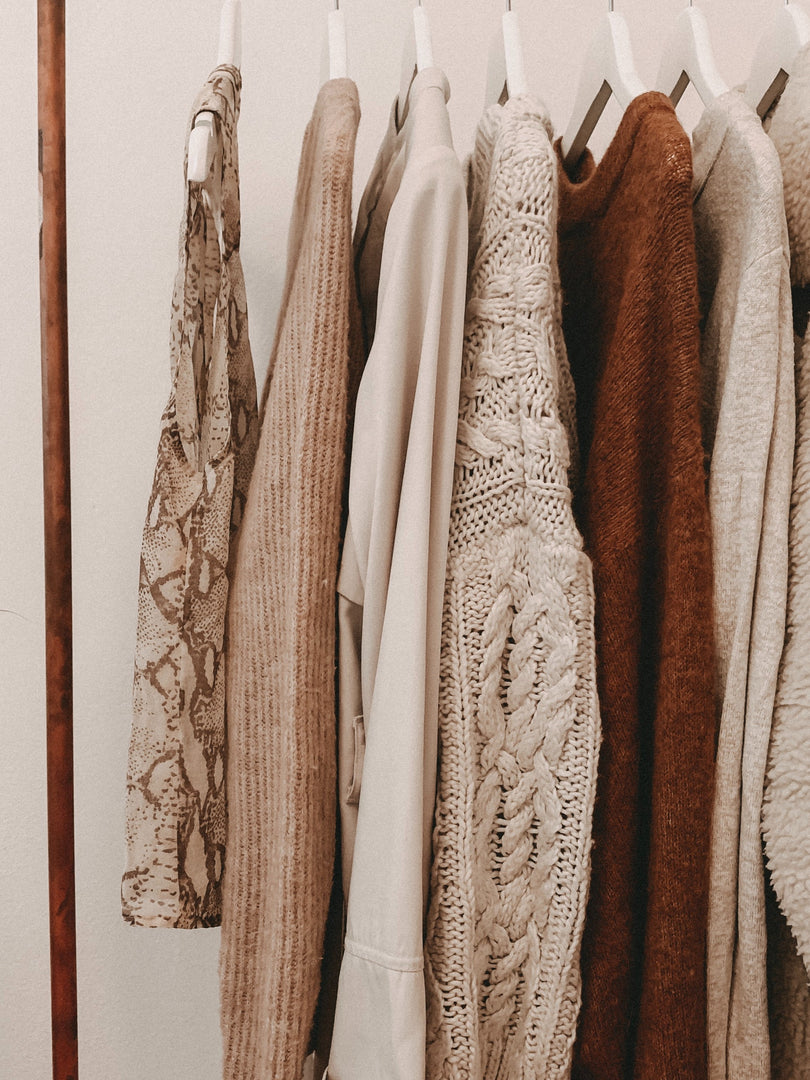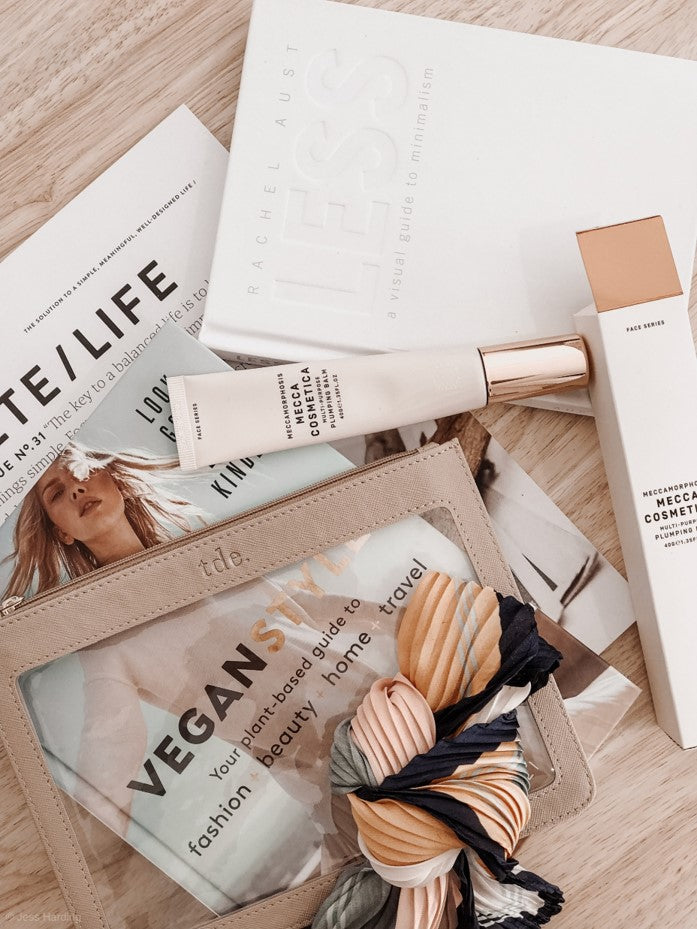Sustainable fashion is a practice and movement to create a fashion industry that better protects and supports the environment and humanity.
This article will cover:
- current issues in the fashion industry
- a brief history of sustainable fashion
- the best and worst fabrics in terms of sustainability
- how to define sustainable fashion based on your values
- different ways to practice shopping sustainably
We hope this will be helpful in answering the question- What is sustainable fashion?
Why does the fashion industry need to become more sustainable?
We are living in an era of intense climate crisis. The effects of global warming are quickly intensifying and becoming increasingly irreversible. In the last 10 years, consumers have become significantly more aware of the impact the fashion industry has on climate change.
10% of humanity’s carbon emissions are attributed to the fashion industry alone, which is more than all international flights and maritime shipping combined. At the current trajectory, the industry’s emissions could jump to 26% by 2050. Fashion is the second largest polluter in the world following the oil industry. Most clothing is produced in China, Bangladesh, or India, countries essentially powered by coal. This is the dirtiest type of energy in terms of carbon emissions.
Thousands of hectares of endangered, ancient forests are cut down and replaced by plantations of trees used to make wood-based fabrics such as rayon. Production of these fabrics leads to deforestation, desertification and soil degradation. This can in turn lead to food insecurity and global warming.
The fashion industry is also the second largest consumer of the world’s water supply. It takes 2000 gallons of water to produce one pair of jeans- that's enough water for one person to drink 8 cups per day for 10 years!
Textile dyeing is the world’s second-largest polluter of water behind agriculture. Water leftover from the dyeing process is often dumped into ditches, streams, or rivers. Wastewater contains toxic substances such as lead, mercury and arsenic, among others. These are extremely harmful for aquatic life and the health of the millions of people living by those rivers banks. The contamination also reaches the sea and eventually spreads around the globe. The fashion industry is responsible for 20% of all industrial water pollution worldwide.
The Dangers of Fast Fashion
Fast fashion is a trend that emerged in the 90’s with affordable retailers like Forever 21 and H&M producing clothing at such a low cost that consumers don’t mind if they only wear the items once. Fast fashion aims to mass produce current trends and styles seen on the runway to sell for a fraction of the price. While the price cut may seem enticing, these micro trends only remain popular for a brief period of time. After this time is up, the clothes get discarded and new micro trends are produced and purchased. This lead to the production of clothing doubling since 2000. Companies went from producing an average of 2 collections a year in 2000 to five in 2011. Major fast fashion brands release even more collections. Zara puts out 24 a year and H&M releases about 16 collections. This “throwaway” culture has led to a massive textile waste issue. More than 15 million tons of used textile waste is generated each year in the United States, and the amount has doubled over the last 20 years. According to the Environmental Protection Agency, more than 75% of clothing is sent to the landfill and less than 15% is recycled by consumers. The average person buys 60% more articles of clothing every year and keeps them for about half as long as 15 years ago, generating a huge amount of clothing waste. This waste can take between 20-200 years to decompose while simultaneously breaking down into plastic microfibers that pollute our oceans. Polyester, a material derived from fossil fuels found in 60% of garments, has extremely high carbon emissions and doesn’t break down in oceans. The equivalent of one garbage truck full of clothes is burned or dumped in a landfill every second.
In order to make clothes quickly and cheaply, fast fashion relies on cheap and toxic textiles, dyes, and working conditions. Companies outsource their labor to third world countries with lax environmental and labor policies like Bangladesh in order to keep their prices low. These factories are extremely unsafe and unregulated. The majority of garment workers are not paid a living wage. Child labor, sexual harassment, and efforts to punish unionized workers are all common conditions in the fashion industry.
Overview & History of Sustainable Fashion
In order to get a complete picture of sustainable fashion, we will overview the socioeconomic events attributed to its rise.
Before 1950- Until this time, clothing production took a tailored, made-to-measure approach. The higher price tags and slower production meant consumers simply owned less clothes.
During World War II (1939-1945)- The make-do-and-mend campaign thrived as a way of rationing clothing. New clothing consumption/production was minimal.
After World War II (1950’s)- The postwar era was a time of economic prosperity. Consumers' purchasing power increased and clothing consumption quickly increased. Production was becoming more mechanized and fast paced.
1960’s- The hippie rebellion made it popular to be aware of the materials you wrap around your body. Natural materials were preferred and a simple and less materialistic way of living was embraced.
1970’s- In 1971, The United States and other nations signed the Multi-Fibre Agreement (MFA), a quota system that limited the number of imports from textile-producing countries. This increased domestic manufacturing costs, fueled globalization, and increased the production of cheaper clothing. Clothing production moved overseas. During the 70’s we also saw second-hand and thrifting becoming popular among all socioeconomic groups for the first time.
1980’s- PETA was founded and due to their fur-free campaigns, there was a decline of fur use in fashion. Companies started campaigning against the use of animals in fashion for the first time. In 1989, the Clean Clothing Campaign was established in the Netherlands. This campaign is dedicated to improving the working conditions of the garment workers in the fashion industry and was the first of its kind.
1990’s- Fast fashion took the world by storm. Companies like Nike were exposed for unethical working conditions for the first time. People started to take notice of factory conditions and workers rights. Following the 1992 Rio Earth Summit, brands like Patagonia commissioned research into finding alternatives for sustainable raw materials sourcing.
Beginning of the 21st century- The World Trade Organization agreement in 2005 made it cheaper and easier to outsource clothing manufacturing. Fast fashion continued to trend upwards. Technological innovations allowed for enhanced traceability and accountability, shortening of the supply chain, and new ways to upcycle and create eco-friendly materials. In 2011, the UN founded the Alliance for Sustainable Fashion which was designed to help the fashion industry contribute to the UN Sustainable Development Goals. The 2013 Rana Plaza Disaster was a wake-up call for many consumers regarding labor conditions in fast fashion.
Today- The 2015 Paris Agreement and the 2019 G7 Summit have highlighted the global necessity to collaborate on climate crisis mitigation. Millennials and Gen Z buyers are demonstrating an unprecedented inclination toward eco-fashion and environmental advocacy. This has led to a new wave of issues involving “greenwashing.” Movements like “Slow fashion” and “Made in the USA” are ramping up. During Covid-19, many brands canceled production and refused to pay workers leading to a series of labor issues.
Which are the Best Sustainable Fabrics?
While shopping for sustainable fashion, it is important to take fabrics and materiality into high consideration. The production of these fabrics has resulted in many of the harmful environmental effects of the fashion industry. Be on the lookout for GOTs certified fabrics. These fabrics are made with a minimum of 70% organic materials and meet strict criteria for dyes, chemicals, water and energy use. In short, the best options are fabrics that are GOT’s certified, certified organic, naturally made and/or biodegradable.
The Best Sustainable Fabrics
- Organic or Recycled Cotton
- Organic Bamboo
- Linen
- Hemp
- Wool
- Cashmere
- Silk
- Modal
- Tencel
- Recycled Polyester (rPet)
Fabrics you should try to avoid
(these fabrics require excessive water-use, harmful synthetic chemicals, and take hundreds of years to degrade!)
- Polyester
- Conventional Cotton
- Acrylic
- Spandex
- Nylon
- Elastane
- Rayon (aka Viscose)
- Faux Leather made from PVC
Fabric choice is a great place to start, but there is so much more that goes into shopping sustainably.
How can I shop sustainably? What does sustainable fashion really mean?
Sustainable fashion is a practice and movement to create a fashion industry that better protects and supports the environment and humanity.
Sustainable fashion considers the social, environmental, and economic price paid by fashion. The term sustainable fashion is not clearly defined. It is a subjective, context-dependent term that means different things to different people. Although it is vague, it cannot be dismissed. Sustainability is defined as meeting the needs of the present without compromising the ability of future generations to meet their needs. Sustainable fashion is about creating a fashion system that can grow and develop in a way that protects the earth and the people on it. Sustainability should be viewed as a philosophical underpinning, a part of the product's core rather than a trend, strategy, or addition. It is a combination of eco-friendly materials, recycling, better working conditions, consuming less, and buying more consciously. First thing you can do is buy less clothing and extend the life of your existing clothes. Buying from sustainable brands is important as well. This should include brands that use recycled, organic, locally sourced and/or eco friendly materials, and that pay their working living wages.
Green Strategy has organized sustainable fashion into 7 different types:
1. Rent, Lease, Swap
Participating in a clothing rental program can be a great option if you still want to keep up with the trends but in a sustainable manner or if you have a special occasion where you may only wear the outfit once or twice. Check out websites like Rent the Runway and Stitch Fix. For a more affordable option, organize and hold a clothing swap with friends or neighbors.
2. Repair, Redesign, Up-cycle,
Prolong your garment's life as long as possible. Pinterest and Youtube have great tutorials for how to repair and up-cycle the clothes you already have. Remember, the most sustainable clothing is the clothing you already own.
3. High Quality, Timeless Design
Less is more. Instead of shopping based on trends, try to shop based on timeless, high quality designs that will always be in fashion. While quality pieces might initially cost more, the longer lifespan and lack of repurchase can offset the initial price jump.
4. Second Hand
Shopping second hand is an accessible and affordable way to shop sustainability. Also, donating your used clothing to thrift stores or selling them on a consignment website is a good way to contribute to circularity and increase the life-span of your clothing.
5. Custom Made
This can mean made-to-order, tailor-made, bespoke, and/or DIY custom made clothing and will reduce overproduction and clothing waste.
6. Fair and Ethical
This includes traditional production, artisan crafts and animal rights. Fairtrade certificated brands are a great place to start.
7. Green and Clean
Look for brands that are transparent and that all phases of production are eco-friendly.
Since sustainable fashion can manifest in vastly different ways, and means different things to different people, ask yourself what are my values regarding sustainability? Then compare that to the values of the brands you are shopping at. Each brand will be different in their definition as to what they consider sustainable fashion to be and how they are implementing these measures. If a company isn’t transparent about their sustainability values and process, they are probably not making their clothes in an ethical and eco-friendly way. Ask yourself, are they actually living up to these values or just aiming to do so? Which values do I care about most? How much do I consume? Brands will go where the market takes them. That means us as consumers have an integral role to vote with our dollar and demand a more sustainable fashion system. Sustainable fashion often has a stigma of being exclusive and expensive. Today, there are plenty of affordable and accessible sustainable options. Find the sustainable fashion option that works for your values and your price point.
We hope this article better helped you answer the question- What is sustainable fashion?
Sustainable fashion is to choose…
Less over more
Quality over quantity
Necessities over temporaries
Slow fashion over fast fashion
Sustainable fashion is not just a trend. It is a mindset, a new way of thinking about, participating in, and structuring fashion.
Sources:
https://thesowell.com/blog/sustainability/what-is-sustainable-fashion/
https://www.thebalancesmb.com/textile-recycling-facts-and-figures-2878122
https://www.weforum.org/agenda/2020/01/fashion-industry-carbon-unsustainable-environment-pollution/
https://www.sustainyourstyle.org/old-environmental-impacts
https://ecothes.com/blog/sustainable-fashion
https://www.hechoxnosotros.org/post/the-history-of-sustainable-fashion
https://sustainablefashionbyraya.com/2021/09/13/the-history-of-sustainable-fashion/
https://medium.com/illumination/what-is-sustainable-fashion-and-why-is-it-important-f8d9a4c1166e
https://www.eco-stylist.com/a-guide-to-the-most-and-least-sustainable-fabrics/











